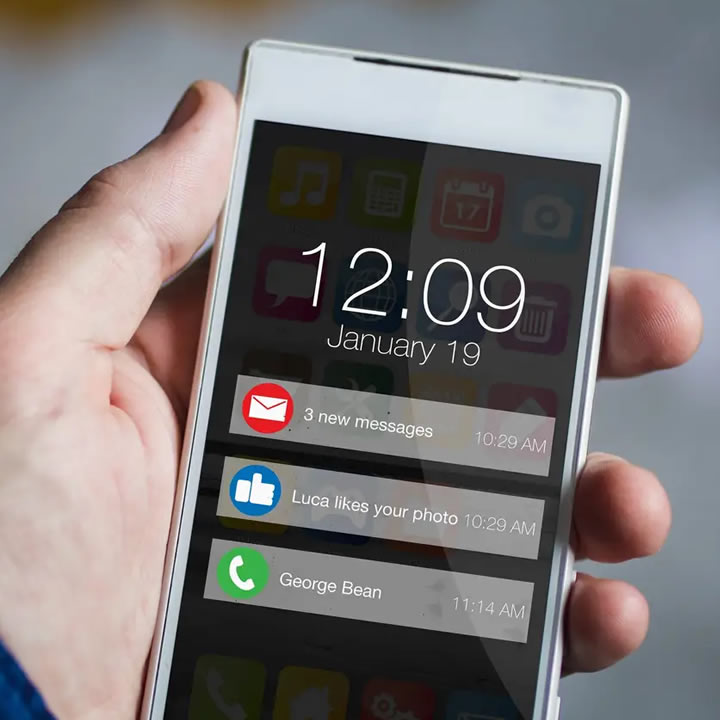The delivery of marketing messages through a technique known as “push,” which can be done on desktop computers as well as mobile devices, is referred to as the practice of push notification marketing.
Push messages are clickable pop-ups that you can send through to the mobile notification center, desktop, or browser of the user, regardless of whether or not the user has visited your website or used your app.
Because you may convince people to use your website or app by sending them to push notifications, push notification marketing is an effective strategy for promoting audience engagement. This is because you can send people alerts directly from your website or app.
When compared to marketing via email, push notifications to have a considerably higher rate of being opened. The research conducted by Reckless found that push alerts had an average open rate of twenty percent, whereas email open rates were less than two percent.
Different Push Notification Types
Push notifications on the web and mobile devices can both be used as a component of your cross-channel marketing plan.
When a user has your app loaded on their mobile device, push notifications can be provided as pop-up messages. The user’s lock screen will display the notifications in the notification center on both Android and Apple devices.
From there, depending on where you want to direct them, they can read the notice to visit your app or mobile site. On smartwatches and other wearables, app push notifications can also be enabled.
According to a 2018 Accengage survey, users of Android smartphones immediately consent to receiving app alerts when they install a new app, meaning that opt-in rates on Android devices are quite high (91.1%).
However, iOS devices need users to provide permission, which results in an average opt-in percentage of 43.9%.
Users receive web push alerts using desktop or mobile web browsers, which slide in at the top or bottom of their screens.
Although they are not yet available for Safari on iOS, they are supported by the majority of popular desktop and mobile browsers, including Google Chrome, Safari (macOS), Microsoft Edge, and Firefox.
Users must agree to receive your notifications by checking a box in their browser.
The opt-in rates for web push notifications now range from 5% to 15%.
Push notifications on the web and on mobile devices can include pictures and links. Moreover, video files, music files, and other types of rich push notifications may be supported by some users’ operating systems.
Use these chances to include rich media in your messaging, such as videos from your company or images of your most recent products. Your messaging will stand out and user interaction with your material will rise if you use rich content.
More people opting in to receive push notifications
It’s crucial to design techniques that will aid you in boosting opt-in rates because the majority of push notification marketing sorts want user consent.
For instance, after they’ve spent several minutes navigating through your website, ask customers to opt-in to push notifications rather than right away. By doing this, you can be sure that they will get an opportunity to realize the value that you offer.
Additionally, you can specify event criteria, such as launching a notification that invites users to sign up for exclusive discounts and offers when they visit a product page. You guys can get premium quality services of push notifications and digital campaigns from RollerAds.
Push Notification Marketing: Use Cases
Delivering effective CTAs through push notifications can motivate your customers to take action.
Some applications for them include:
Having a momentary sale
If you’re running a special campaign, let people know about it using push notifications, email marketing, and SMS marketing. When choosing your channel delivery format, consider which channels each user is most likely to interact with.
Personalized product recommendations are also shared
You may push highly individualized offers that customers are more likely to interact with by segmenting your audience based on their consumer preferences, buy history, and behavioral data.
For instance, Ticketmaster employs push notifications to let audience members know about forthcoming performances in genres that they have already indicated an interest in.
“What did you forget?” notification
You can utilize a push notification to persuade a consumer who has abandoned their shopping basket to come back to your website or app and complete their purchase. You could even entice them with a special discount coupon.
Notifying customers of your most recent article or ebook
Make use of push notifications to sell your content. This approach can help clients develop confidence in your company by engaging them with educational and entertaining material about the subjects that they care about, as opposed to making a sales pitch.
Within cross-channel marketing, push notification marketing
Your cross-channel marketing approach may benefit greatly from the use of push notification marketing. You can create highly personalized, sequenced messages to engage with your customers across all of their devices and channels using a cross-channel marketing platform like Iterable.
These messages can include email, SMS, push, in-app, web push, direct mail, and social retargeting.
You can deliver pertinent content that’s intended to meet the user where they’re most likely to engage with you by setting up workflows that cause push notifications and other types of messages based on the user’s interests and behavior.
Push notification marketing will enable you to reach your audience through a channel that is optimized for high click-through rates and maximum customer engagement.
To create an integrated, cohesive messaging strategy that will reach your audience at the right time and place, regardless of how they prefer to engage with your brand, combine push notification marketing with the other channels your audiences use.

